Ethanethiol,2-[bis(1-methylethyl)amino]-, hydrochloride (1:1)
Modify Date: 2024-01-19 19:05:41
![Ethanethiol,2-[bis(1-methylethyl)amino]-, hydrochloride (1:1) Structure](https://image.chemsrc.com/caspic/228/41480-75-5.png)
Ethanethiol,2-[bis(1-methylethyl)amino]-, hydrochloride (1:1) structure
|
Common Name | Ethanethiol,2-[bis(1-methylethyl)amino]-, hydrochloride (1:1) | ||
|---|---|---|---|---|
| CAS Number | 41480-75-5 | Molecular Weight | 197.76900 | |
| Density | 0.883g/cm3 | Boiling Point | 191.3ºC at 760 mmHg | |
| Molecular Formula | C8H20ClNS | Melting Point | N/A | |
| MSDS | N/A | Flash Point | 69.5ºC | |
| Name | 2-[di(propan-2-yl)amino]ethanethiol,hydrochloride |
|---|---|
| Synonym | More Synonyms |
| Density | 0.883g/cm3 |
|---|---|
| Boiling Point | 191.3ºC at 760 mmHg |
| Molecular Formula | C8H20ClNS |
| Molecular Weight | 197.76900 |
| Flash Point | 69.5ºC |
| Exact Mass | 197.10000 |
| PSA | 42.04000 |
| LogP | 2.83700 |
Synonym:2-(Bis(1-Methylethyl)Amino)-Ethanethiol, Hydrochloride Section 2 - COMPOSITION, INFORMATION ON INGREDIENTS
Risk Phrases: 36/37/38 Section 3 - HAZARDS IDENTIFICATION EMERGENCY OVERVIEW
Irritating to eyes, respiratory system and skin.The toxicological properties of this material have not been fully investigated.Stench. Potential Health Effects Eye: Causes eye irritation. May cause chemical conjunctivitis. Skin: Causes skin irritation. Ingestion: May cause gastrointestinal irritation with nausea, vomiting and diarrhea. The toxicological properties of this substance have not been fully investigated. Inhalation: The toxicological properties of this substance have not been fully investigated. Can produce delayed pulmonary edema. Causes irritation of the mucous membrane and upper respiratory tract. Chronic: Effects may be delayed. Section 4 - FIRST AID MEASURES Eyes: Immediately flush eyes with plenty of water for at least 15 minutes, occasionally lifting the upper and lower eyelids. Get medical aid. Skin: Get medical aid. Immediately flush skin with plenty of water for at least 15 minutes while removing contaminated clothing and shoes. Wash clothing before reuse. Ingestion: Never give anything by mouth to an unconscious person. Get medical aid. Do NOT induce vomiting. If conscious and alert, rinse mouth and drink 2-4 cupfuls of milk or water. Inhalation: Remove from exposure and move to fresh air immediately. If breathing is difficult, give oxygen. Get medical aid. Do NOT use mouth-to-mouth resuscitation. If breathing has ceased apply artificial respiration using oxygen and a suitable mechanical device such as a bag and a mask. Notes to Physician: Treat symptomatically and supportively. Section 5 - FIRE FIGHTING MEASURES General Information: As in any fire, wear a self-contained breathing apparatus in pressure-demand, MSHA/NIOSH (approved or equivalent), and full protective gear. During a fire, irritating and highly toxic gases may be generated by thermal decomposition or combustion. Runoff from fire control or dilution water may cause pollution. Extinguishing Media: Use water spray, dry chemical, carbon dioxide, or appropriate foam. Section 6 - ACCIDENTAL RELEASE MEASURES General Information: Use proper personal protective equipment as indicated in Section 8. Spills/Leaks: Vacuum or sweep up material and place into a suitable disposal container. Clean up spills immediately, observing precautions in the Protective Equipment section. Avoid generating dusty conditions. Provide ventilation. Section 7 - HANDLING and STORAGE Handling: Minimize dust generation and accumulation. Avoid contact with eyes, skin, and clothing. Keep container tightly closed. Avoid ingestion and inhalation. Use with adequate ventilation. Wash clothing before reuse. Storage: Store in a tightly closed container. Store in a cool, dry, well-ventilated area away from incompatible substances. Section 8 - EXPOSURE CONTROLS, PERSONAL PROTECTION Engineering Controls: Facilities storing or utilizing this material should be equipped with an eyewash facility and a safety shower. Use adequate ventilation to keep airborne concentrations low. Exposure Limits CAS# 41480-75-5: Personal Protective Equipment Eyes: Wear appropriate protective eyeglasses or chemical safety goggles as described by OSHA's eye and face protection regulations in 29 CFR 1910.133 or European Standard EN166. Skin: Wear appropriate protective gloves to prevent skin exposure. Clothing: Wear appropriate protective clothing to prevent skin exposure. Respirators: A respiratory protection program that meets OSHA's 29 CFR 1910.134 and ANSI Z88.2 requirements or European Standard EN 149 must be followed whenever workplace conditions warrant respirator use. Section 9 - PHYSICAL AND CHEMICAL PROPERTIES Physical State: Powder Color: moist, white to off-white Odor: unpleasant odor pH: Not available. Vapor Pressure: Not available. Viscosity: Not available. Boiling Point: Not available. Freezing/Melting Point: Not available. Autoignition Temperature: Not available. Flash Point: Not available. Explosion Limits, lower: Not available. Explosion Limits, upper: Not available. Decomposition Temperature: Solubility in water: Specific Gravity/Density: Molecular Formula: C8H19NSClH Molecular Weight: 197.6597 Section 10 - STABILITY AND REACTIVITY Chemical Stability: Stable at room temperature in closed containers under normal storage and handling conditions. Conditions to Avoid: Incompatible materials, dust generation, excess heat. Incompatibilities with Other Materials: Oxidizing agents. Hazardous Decomposition Products: Nitrogen oxides, carbon monoxide, carbon dioxide, nitrogen, sulfur oxides (SOx), including sulfur oxide and sulfur dioxide. Hazardous Polymerization: Has not been reported Section 11 - TOXICOLOGICAL INFORMATION RTECS#: CAS# 41480-75-5 unlisted. LD50/LC50: Not available. Carcinogenicity: 2-(Diisopropylamino)-Ethanethiol Hydrochloride - Not listed by ACGIH, IARC, or NTP. Section 12 - ECOLOGICAL INFORMATION Section 13 - DISPOSAL CONSIDERATIONS Dispose of in a manner consistent with federal, state, and local regulations. Section 14 - TRANSPORT INFORMATION IATA No information available. IMO No information available. RID/ADR No information available. Section 15 - REGULATORY INFORMATION European/International Regulations European Labeling in Accordance with EC Directives Hazard Symbols: XI Risk Phrases: R 36/37/38 Irritating to eyes, respiratory system and skin. Safety Phrases: S 24/25 Avoid contact with skin and eyes. WGK (Water Danger/Protection) CAS# 41480-75-5: No information available. Canada None of the chemicals in this product are listed on the DSL/NDSL list. CAS# 41480-75-5 is not listed on Canada's Ingredient Disclosure List. US FEDERAL TSCA CAS# 41480-75-5 is not listed on the TSCA inventory. It is for research and development use only. SECTION 16 - ADDITIONAL INFORMATION N/A |
| HS Code | 2930909090 |
|---|
|
~% ![Ethanethiol,2-[bis(1-methylethyl)amino]-, hydrochloride (1:1) Structure](https://image.chemsrc.com/caspic/228/41480-75-5.png)
Ethanethiol,2-[... CAS#:41480-75-5 |
| Literature: Mahmoudkhani, Amir Hossein; Langer, Vratislav Acta Crystallographica Section C: Crystal Structure Communications, 1999 , vol. 55, # 7 p. 1163 - 1167 |
|
~% ![Ethanethiol,2-[bis(1-methylethyl)amino]-, hydrochloride (1:1) Structure](https://image.chemsrc.com/caspic/228/41480-75-5.png)
Ethanethiol,2-[... CAS#:41480-75-5 |
| Literature: Mahmoudkhani, Amir Hossein; Langer, Vratislav Acta Crystallographica Section C: Crystal Structure Communications, 1999 , vol. 55, # 7 p. 1163 - 1167 |
| Precursor 2 | |
|---|---|
| DownStream 0 | |
| HS Code | 2930909090 |
|---|---|
| Summary | 2930909090. other organo-sulphur compounds. VAT:17.0%. Tax rebate rate:13.0%. . MFN tariff:6.5%. General tariff:30.0% |
| 2-(Diisopropylamino)ethanethiol hydrochloride |
| diisopropyl (2-mercaptoethyl) ammonium chloride |
| 2-[di(propan-2-yl)amino]ethanethiol hydrochloride |
| 2-diisopropylaminoethanethiol hydrochloric acid salt |
| EINECS 255-389-1 |
| 2-(Diisopropylamino)ethanethiol HCl |
| N,N-diisopropyl-2-aminoethanethiol hydrochloride |

